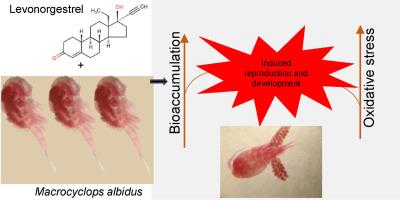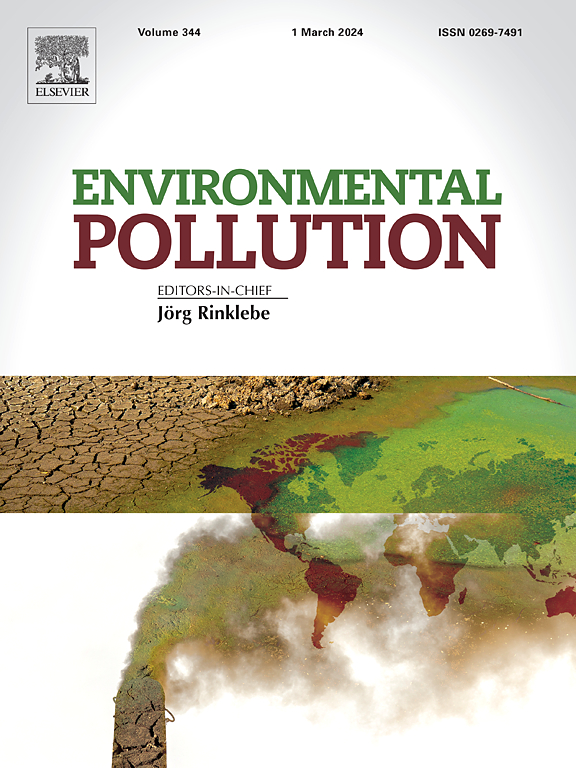The contraceptive active ingredient levonorgestrel disrupts the physiology of Macrocyclops albidus
IF 7.3
2区 环境科学与生态学
Q1 ENVIRONMENTAL SCIENCES
引用次数: 0
Abstract
Active pharmaceutical ingredients, such as levonorgestrel (LNG), continue to increase in aquatic ecosystems and are detected in environmental matrices; however, their ability to bioaccumulate and cause reproductive, developmental, and biochemical defects in benthic organisms, such as Macrocyclops albidus, is unknown. This study investigated the effects of LNG on the oxidative stress response, reproduction, and development of M. albidus. Levonorgestrel induced a significant (p<0.05) increase in total protein with increasing concentrations from 10 ng L-1. Intracellular hydrogen peroxide levels were elevated after exposure to LNG (p<0.05). Malondialdehyde level declined as LNG concentration increased at day 7 and increased at higher LNG at day 14. Peroxidase activity was significantly (p<0.05) elevated by lower (1-100 ng L-1) than higher (1000-10000 ng L-1) concentrations of LNG. Glutathione S-transferase activity declined with increasing concentrations of LNG. Increased metamorphosis from the nauplii to the copepodite stage was significantly induced by 1000 and 10000 ng L-1 LNG within four days of exposure. In addition, higher concentrations of LNG induced early production of egg sacs in female M. albidus within four days. Levonorgestrel bioaccumulated in M. albidus, with higher tissue concentrations occurring at high exposures. This study revealed that LNG is readily absorbed and causes stress by interfering with reproduction and metamorphosis in M. albidus, thereby highlighting the role of this zooplankton as a sensitive bioindicator of endocrine disruptors in aquatic ecosystems.

避孕活性成分左炔诺孕酮破坏大斜眼的生理机能
活性药物成分,如左炔诺孕酮(LNG),在水生生态系统中继续增加,并在环境基质中被检测到;然而,它们在底栖生物(如大cyclops albidus)中生物积累和引起生殖、发育和生化缺陷的能力尚不清楚。本研究探讨了LNG对绿僵菌氧化应激反应、繁殖和发育的影响。左炔诺孕酮从10 ng L-1开始,随着浓度的增加,总蛋白显著(p<0.05)增加。暴露于LNG后,细胞内过氧化氢水平升高(p<0.05)。第7天,丙二醛水平随着LNG浓度的增加而下降,第14天,LNG浓度较高时丙二醛水平升高。低浓度(1-100 ng L-1)的过氧化物酶活性显著(p<0.05)高于高浓度(1000-10000 ng L-1)的过氧化物酶活性。谷胱甘肽s -转移酶活性随着LNG浓度的增加而下降。1000和10000 ng L-1的LNG在4天内显著诱导幼体向桡足动物阶段的蜕变。此外,高浓度的LNG诱导雌蜂在4天内提早产生卵囊。左炔诺孕酮在M. albidus体内生物积累,高暴露时组织浓度较高。本研究表明,LNG很容易被吸收,并通过干扰M. albidus的繁殖和变态而引起应激,从而突出了这种浮游动物作为水生生态系统中内分泌干扰物的敏感生物指示物的作用。
本文章由计算机程序翻译,如有差异,请以英文原文为准。
求助全文
约1分钟内获得全文
求助全文
来源期刊

Environmental Pollution
环境科学-环境科学
CiteScore
16.00
自引率
6.70%
发文量
2082
审稿时长
2.9 months
期刊介绍:
Environmental Pollution is an international peer-reviewed journal that publishes high-quality research papers and review articles covering all aspects of environmental pollution and its impacts on ecosystems and human health.
Subject areas include, but are not limited to:
• Sources and occurrences of pollutants that are clearly defined and measured in environmental compartments, food and food-related items, and human bodies;
• Interlinks between contaminant exposure and biological, ecological, and human health effects, including those of climate change;
• Contaminants of emerging concerns (including but not limited to antibiotic resistant microorganisms or genes, microplastics/nanoplastics, electronic wastes, light, and noise) and/or their biological, ecological, or human health effects;
• Laboratory and field studies on the remediation/mitigation of environmental pollution via new techniques and with clear links to biological, ecological, or human health effects;
• Modeling of pollution processes, patterns, or trends that is of clear environmental and/or human health interest;
• New techniques that measure and examine environmental occurrences, transport, behavior, and effects of pollutants within the environment or the laboratory, provided that they can be clearly used to address problems within regional or global environmental compartments.
 求助内容:
求助内容: 应助结果提醒方式:
应助结果提醒方式:


